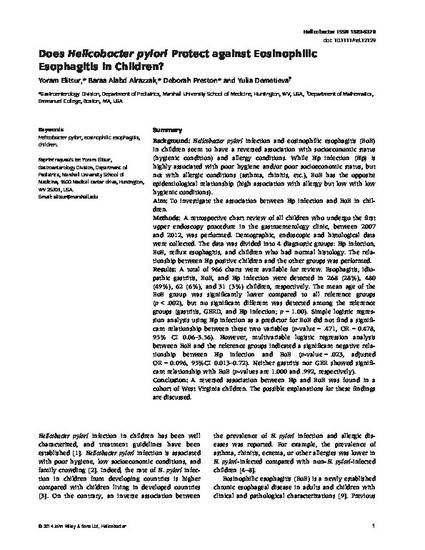
Article
Does Helicobacter pylori Protect against Eosinophilic Esophagitis in Children?
Helicobacter
(2014)
Abstract
Background: Helicobacter pylori infection and eosinophilic esophagitis (EoE)
in children seem to have a reversed association with socioeconomic status
(hygienic condition) and allergy conditions. While Hp infection (Hp) is
highly associated with poor hygiene and/or poor socioeconomic status, but
not with allergic conditions (asthma, rhinitis, etc.), EoE has the opposite
epidemiological relationship (high association with allergy but low with low
hygienic conditions).
Aim: To investigate the association between Hp infection and EoE in children.
Methods: A retrospective chart review of all children who undergo the first
upper endoscopy procedure in the gastroenterology clinic, between 2007
and 2012, was performed. Demographic, endoscopic and histological data
were collected. The data was divided into 4 diagnostic groups: Hp infection,
EoE, reflux esophagitis, and children who had normal histology. The relationship
between Hp positive children and the other groups was performed.
Results: A total of 966 charts were available for review. Esophagitis, idiopathic
gastritis, EoE, and Hp infection were detected in 268 (28%), 480
(49%), 62 (6%), and 31 (3%) children, respectively. The mean age of the
EoE group was significantly lower compared to all reference groups
(p < .002), but no significant different was detected among the reference
groups (gastritis, GERD, and Hp infection; p = 1.00). Simple logistic regression
analysis using Hp infection as a predictor for EoE did not find a significant
relationship between these two variables (p-value = .471, OR = 0.478,
95% CI 0.06–3.56). However, multivariable logistic regression analysis
between EoE and the reference groups indicated a significant negative relationship
between Hp infection and EoE (p-value = .023, adjusted
OR = 0.096, 95%CI 0.013–0.72). Neither gastritis nor GER showed significant
relationship with EoE (p-values are 1.000 and .992, respectively).
Conclusion: A reversed association between Hp and EoE was found in a
cohort of West Virginia children. The possible explanations for these findings
are discussed.
Keywords
- Helicobacter pylori,
- eosinophilic esophagitis,
- children
Disciplines
Publication Date
October, 2014
DOI
10.1111/hel.12129
Citation Information
Yoram Elitsur, Baraa Alabd Alrazzak, Deborah L. Preston and Yulia Demetieva. "Does Helicobacter pylori Protect against Eosinophilic Esophagitis in Children?" Helicobacter Vol. 19 Iss. 5 (2014) p. 323 - 329 ISSN: 1523-5378 Available at: http://works.bepress.com/yoram_elitsur/19/
